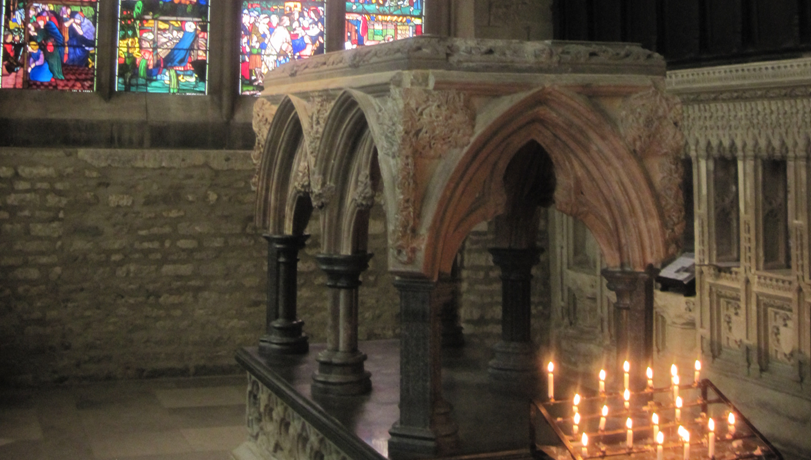 |
| St. Paul's Episcopal Church, Hebron, 1773. |
Any visitors to the Eastern Shore of Maryland can find in the old town on the rivers and backwater creeks of the Chesapeake water shed the relics of the United States' earliest Christianity.
The Chesapeake coasts of Maryland like those of Virginia were home to many settlements of Englishmen as early as the mid 1600s. While the rest of Maryland began as a Roman Catholic colony run by Maryland's proprietors, the Roman Lord Baltimores, the Chesapeake was settled by the Anglicans like most settlers of the Virginia colony. Naturally the more secure these communities became, their inhabitants, accustomed to the Church of England soon demanded the bringing of Anglican priests to their towns from their proprietors. In 1689, just after the Glorious Revolution in England, Maryland's Anglican Englishmen, disgruntled with the colonial government's refusal to sustain Anglican Priests, and who now outnumbered the English Catholics, overthrew the Proprietary Government and demanded that the English Monarchy, William and Mary, make Maryland a royal colony and establish the Church of England (Anglican). By 1692, the Anglican Church was made the established church in Maryland and the people were ordered to divide Maryland into 30 parishes each with Church buildings, elected vestries and Anglican Priests sustained by colonial taxes levied by the colonial legislature.
In the decades following the acts of 1692, each parish fostered the growth of the Church of England in Maryland. As the Chesapeake regions of Maryland were mainly Anglican, the towns that remain their today are still home to the Churches founded by their early settlers. The revolution left the Church of England in America, by then established in most colonies, in a state of confusion until it organised itself into the Episcopal Church of the United States of America, after receiving Apostolic Succession from the Scottish non-juring bishops.
The result of Maryland's Anglican Church establishment in the once profitable Chesapeake region is that many of the Church buildings of the area have early foundation and retain the 17th-18th century qualities of Anglican Church building. Besides owning silver chalices and plate given by Queen Anne in 1710 or by other distinguished parishoners, they also retain original English baroque style pulpits box-pews and altar, and reredoses with the Decalogue, Our Father and Apostles' Creed. I think that they can somewhat resemble small Christopher Wren chapels if he ever built such a thing.
Old Trinity, Church Creek MD


It is thought that Old Trinity was built as early as1675, making it one of the original Anglican parishes before the Establishment in 1692. It is possibly the oldest Episcopal Church still in use and one of the oldest churches still in use of the 13 colonies. Old Trinity, like many other churches was built close to the water so that parishioners coming from all over would be able to get to church by water rather that by the thin paths and wild roads. These churches came to be known as 'water-churches.' The bottom picture is taken through a blurry window in the rounded apse and so unfortunately does not show the 'Wren like' architecture, but it does show the gallery in the back with the Stuart coat of arms, box-pews and the large pulpit.
St. Luke's Church, Wye Mills MD.
The church in Wye Mills is one of the most impressive buildings on the Eastern Shore if not in all of Maryland. The church was begun in 1717 by order of vestry and finished in 1721 for a cost of one hundred pounds, sterling, and over sixty thousand pounds of tobacco. The church has had to rebuild its box-pews after they were removed for some-time but was able to do this according to the original style because the church retained a plan indicating which families owned which pews. It has seen a few decades of neglect but has been beautifully restored to its original appearance begun in the mid-1800s after Bishop Whittingham of Maryland made requests for its restoration. Today the church still remains part of the Episcopal Church and has services every Sunday.
Christ Church, St. Michael's MD.
This very fine silver plate can be seen at the back of Christ Church, St. Michael's on display. Christ Church's foundation goes back to the 'Act of Establishment' in 1692 although the current building is Victorian, neo-gothic from the late 19th century. The chalice and flagon were presented to the parish in 1710 by Queen Anne along with a marble baptismal bowl. The Queen was sympathetic to the Anglican churches in the colonies and endowed many parishes with silver plate, King James Bibles and Books of Common Prayer. The episcopal church in North East, Maryland is named St. Mary Anne's not for a saint called 'Mary-Anne' but for the Blessed Virgin Mary. They then called the church 'Anne's' after the Queen's gifts of plate and a lectern bible.
St. Mary Anne's Episcopal Church, 1743, North East, MD.
All Hallows' Snow Hill, MD.
Similarly a church in Snow Hill, settled by emigrants from Snow Hill in London, was erected in 1748 on an initial levy of 80,000 pounds of tobacco. The church is also reminiscent of a Wren church if compared to the facad of St. Mary-le-Bow in London. It retains several treasures given by Queen Anne including a bible, a silver Communion set, a Eucharistic veil, and a bell.
The Eastern Shore of Maryland has many more churches like these so I cannot, unfortunatly, include evry single one here. But some other churches of interest include: St. Paul's Hebron, St. Peter's Salisbury, St. Andrew's Princess Anne, Christ Church Cambridge, Christ Church Easton, Emmanuel Chestertown, St. Luke's Church Hill, Christ Church Worton and even several others.
Much thanks to my lovely Grandmother who visited these churches with me with equal interest!
Also much thanks to the respective websites of these churches:
http://allhallowssnowhill.org/
http://www.oldtrinity.net/
http://www.stmaryanne.org/
http://stpaulshebron.wordpress.com/
http://www.wyeparish.org/
http://www.christstmichaels.org/












